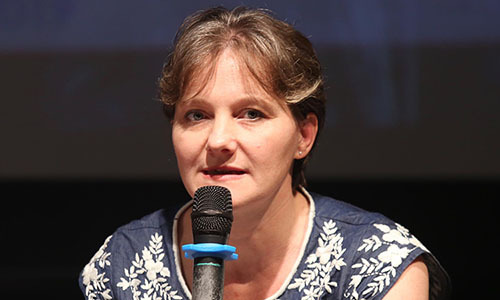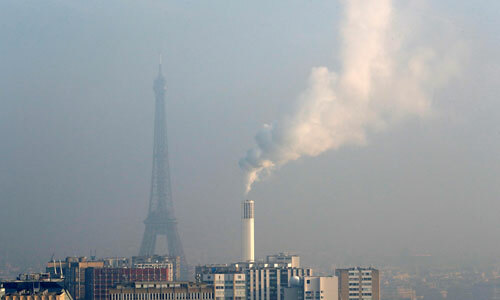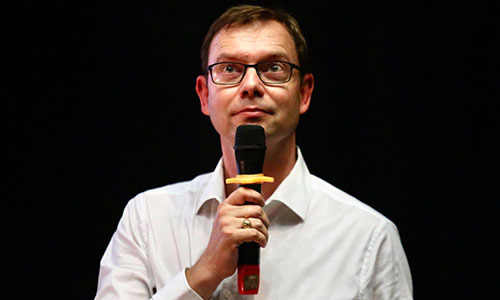Paris identified private vehicles as a major cause of air pollution and took drastic measures to address them, according to two French experts.
"Cities face a lot of problems with air pollution. There are many issues that need to be addressed. It is important to identify the causes of air pollution, just like patients need to be diagnosed with the right disease to prescribe and offer treatment regimen, "said Karine Leger, director of the Paris AirParif air quality management network, speaking at a seminar on air pollution at the French Cultural Center in Hanoi this afternoon.

Karine Leger, Director of Airparif, Paris air quality network at a seminar in Hanoi in the afternoon of October 12 Photo: Jiazheng.
According to Ms. Leger, the first problem caused by air pollution is human health. According to statistics, there are about 8 million premature deaths from air pollution in the world each year. The second problem is the impact on biodiversity, contributing to climate change and the third is the legal issues, when many citizens or NGOs in Paris have ever sued the government. because of air pollution.
She contends that current air pollution is like the tip of an iceberg, which takes place not only for a few days or weeks, but is always latent at all times. Air pollution mainly occurs in poor countries and developing countries, but developed areas such as Paris, France, also suffer from this situation.
Paris is more than 9,000 km from Hanoi, but there is a common concern about air pollution, Leger said. In Paris, pollution was not a new problem, but appeared as early as the 19th century and the early 20th century, when industries developed.
Paris is currently the most populous city in Europe and one of the 10 most populous cities in the world with 2.2 million people per 100 km2 and an urban area of 11 million. Parisians are very concerned about air quality, especially outdoor air quality.
"The city government has determined that the cause of air pollution is mainly due to traffic, in addition to the heaters used to warm homes in the winter. Since then, Paris has made efforts throughout. for nearly 20 years to improve air quality, "says Leger.
In 2004, the Paris Council adopted the first Climate Plan. In 2018, the Council set new goals for the Paris metropolitan area for 2024, the year to host the Olympic Games and 2030, referring urgent actions for the benefit of pedestrians, cyclists and deliveries. public communication. In 2017, the first French Low Emission Zone was created.

A view from the AirParif Generali balloon shows the Eiffel Tower through a small-particle haze as air pollution levels rise in Paris on January 23 Photo: Reuters
Olivier Chretien, head of the Environmental Impact Department of the Paris City Urban Ecology Committee, also said that identifying the main cause of air pollution is a core issue in helping the Paris government to issue suitable solution.
After identifying the main cause of air pollution coming from traffic, the city has focused on measures such as reducing the flow of cars in circulation, and controlling and cutting down the maximum amount of toxic emissions. emissions from vehicles by numbering 1 to 5 for vehicle emissions level.
From 2001 to 2018, the Paris government focused on implementing environmental protection measures, most notably developing public transportation, walking and bicycle priority. The Seine embankment road is designed exclusively for these subjects.
Paris renovated 7 large squares in the city, deployed a new tram network in the ring area, ensuring fast buses and buses to meet the travel needs of the people. "In Paris, there is a metro every 500 meters and this has been done for half a century. Architectural planning issues are also needed to ensure the most convenient travel needs of the people. people, "said Chretien.
Bicycle-specific roads have been expanded, Velib bicycle rental network has been developed and upgraded, encouraging people to use this type of vehicle. In addition, the network of carpooling or leasing carts and specialized vehicles was also developed.
Answering VnExpress about the experience of handling lead pollution after the Notre Dame Cathedral fire on April 15, two French experts said the affected area was mainly in the District 1 area of Paris. This is considered a complex issue, not just air pollution, because polluted lead dust can accumulate on the ground and fly into the surrounding environment.

Olivier Chretien, Head of Environmental Impact Division of Paris City Urban Ecology Committee at a seminar in Hanoi in the afternoon of October 12 Photo: Jiazheng.
"The initial measures that the city government took were explaining, communicating to the people, implementing a surface cleaning campaign to minimize the impact of lead pollution on the environment," Chretien said.
In order to limit the impact from air pollution, Paris also focuses on spatial restructuring, such as moving people in areas exposed to polluted air, actively deploying communication measures on pollution, including the AirParif system.
AirParif is the unique and unique air quality management network in the world, constantly updating expert opinions and ideas to explain to people about the situation and quality of air.
As a result, during the period 2001-2018, the French capital reduced traffic volume by 30% and reduced CO2 emissions by 22% from 2005 to 2015.
However, Chretien also highlighted the difficulties of Paris in implementing measures to reduce air pollution. In the process of limiting transport, many poor and low-income people cannot afford to exchange new vehicles to ensure emission standards.
According to him, the government needs financial support, there are subsidy measures to help them switch to cars that meet emissions standards. In addition, the authorities need strict monitoring of vehicle emissions, installation of sensor stations and environmental taxation for businesses.
He also pointed out the existing problems of Paris that have not eliminated diesel cars and replaced cars with less polluting vehicles. In addition, the issue of people using open fireplaces, the main source of emissions causing fine dust (PM2.5), has not been completely solved. "People's awareness of indoor air quality issues still needs to be changed," he said.



 BonnieCrossman
BonnieCrossman







